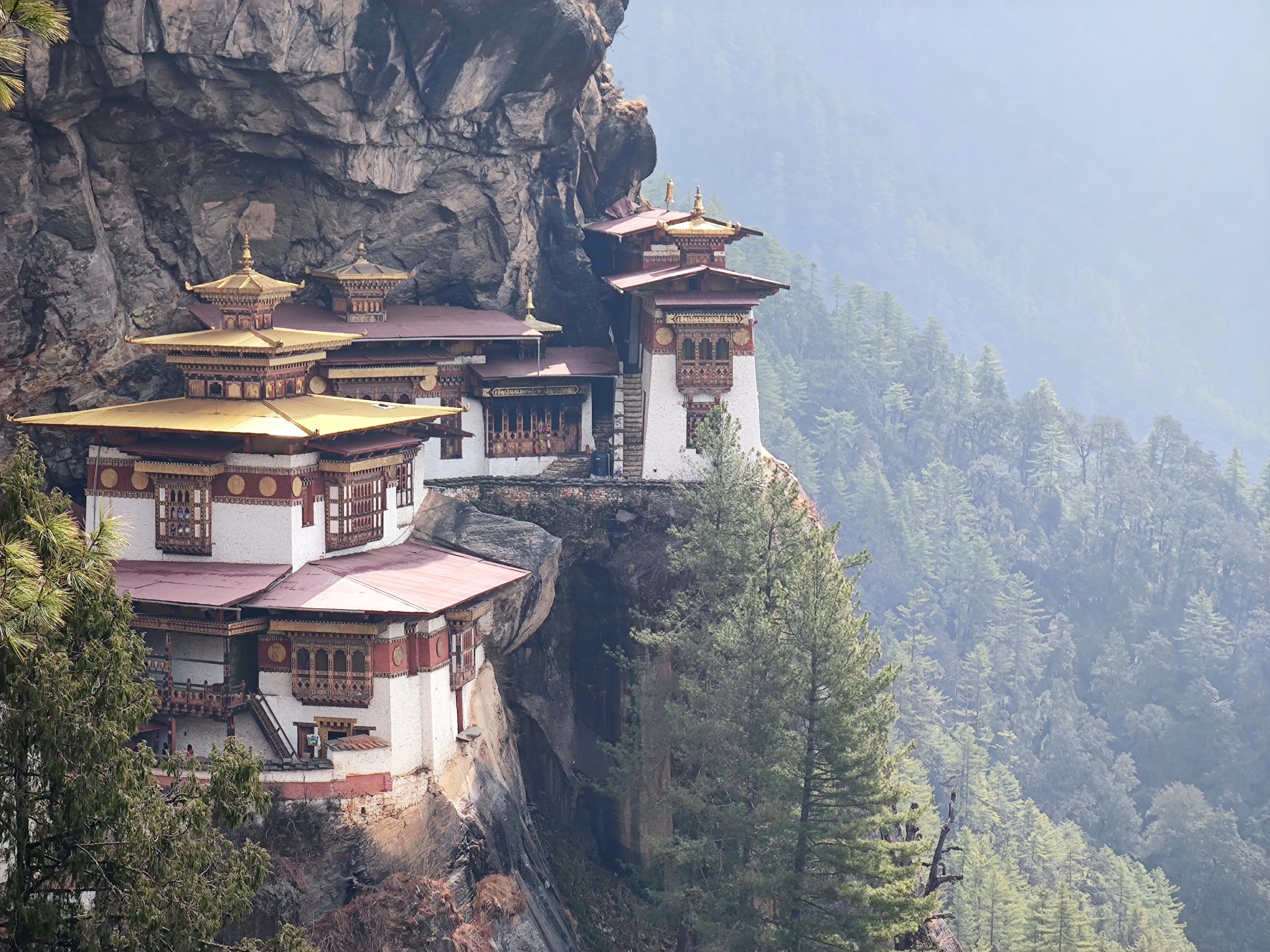
A Day at Bhutan’s Crown Jewel, the Tiger’s Nest Monastery – Day 4
Our final day in Bhutan unfolds with a sense of anticipation as we embark on a remarkable journey to Paro Taktsang, also known as the “Tiger’s Nest Monastery,” a sacred edifice dating back to 1692. Perched on the precipice at an elevation of 900 meters above the enchanting Paro Valley, this UNESCO World Heritage Site promises a captivating experience.
Setting out early, our guide, a seasoned explorer of the monastery, accompanies us on this spiritual ascent, leaving behind our driver at the foot of the mountain. There, a cluster of horses awaits, providing assistance to fellow travelers, particularly Indian tourists, who occasionally find the rigorous climb challenging. Our guide and driver have trodden this path multiple times.
Ascending, we encounter scattered stupas lining the route, each holding a dual purpose. Firstly, they serve as historical markers, a practice born from a time when the trail lacked such guideposts. Those who walked the right path left behind these silent guides for those who would follow. Secondly, the stupa, typically a Buddhist monument enshrining relics associated with revered figures, takes on a more personal role. It becomes a blessing for individuals who may not construct a full-fledged stupa in their lifetime. Instead, they craft a miniature version from the stones along the way, ensuring that the journey itself becomes a source of spiritual grace.

The winding road uphill may be lengthy, but it adds to the pilgrimage’s charm. There’s a deliberate choice in making holy places a bit challenging to reach; it preserves the sanctity of the experience. A dedicated pilgrim can truly demonstrate devotion through a strenuous journey, a test that the less sincere might avoid. The walking path has improved, now featuring steps added post-pandemic, making the climb less arduous than before. However, we opt for the local route – a straighter, albeit steeper trail without steps.
The hearty breakfast included in the hotel stay proves a slight inconvenience; climbing on a full stomach is no easy feat. Yet, for the mountain-dwelling locals, it’s a routine they’ve acclimated to over time. Along the ascent, designated rest areas offer breathtaking vistas of the rock monastery, complemented by a waterfall believed to be blessed by the God of Life. The water is said to bestow longevity, prompting us to not just drink it but also apply it to our foreheads and hair, a ritual guided by tradition. The guide playfully reminds us not to startle the mountain dogs, assuring us that the holy water is a germ-free blessing.
Surprisingly, the trail sees its fair share of foreigners. Engaging in conversation, a gentleman from Kazakhstan shares his journey—Nepal, then Bhutan, and next, like us, Bangladesh. He humorously notes that living in the mountains makes it easier for him, contrasting the flatness of our homeland.
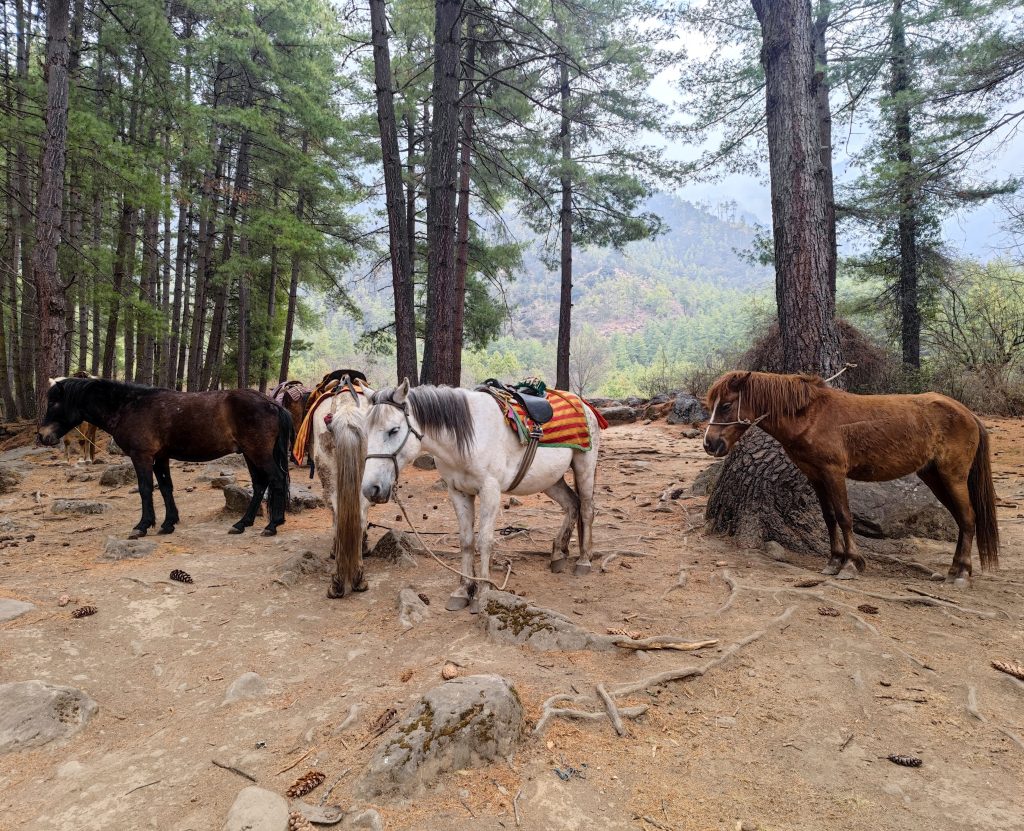
En route, we immerse ourselves in the fascinating tale of how this monastery came into existence. Naturally, the narrative begins with the first Buddha, the pioneer who initiated the global spread of Buddhism. Bhutan embraced Buddhism through the efforts of the second Buddha, born in what is now Pakistan and emerging from a lotus flower.
Driven to propagate Buddhism, the second Buddha found his greatest success in the realm of Bhutan, despite having three wives—one in Tibet, one in India, and one in Bhutan. An intriguing chapter unfolds when the Bhutanese wife, meditating in a mountain cave, faced constant disruptions from a demon. This malevolent force, a demon girl, sought to thwart the spread of Buddhism in the Himalayan region. In response, the second Buddha assumed the form of the “fighting image” and soared to the cave on the back of a tigress. This bold move expelled the demon by erecting 108 temples in the vicinity. The very temple we approach stands on the left leg of the demon girl, while another in central Bhutan rests on her knee, underscoring the enormity of this celestial confrontation. Regrettably, the other temples in the area fell into neglect and have not endured, leaving only these two in Bhutan to recount the triumph.
Concurrently, the cave where the guru’s wife meditated evolved into a meditation hub, drawing lamas from far and wide. It’s noteworthy that this episode is linked to one of the Buddha’s reincarnations. When a person attains enlightenment, they leave behind “treasures” or hidden signs across the world for their future reincarnations to discover—an organic continuation along the Buddhist path.
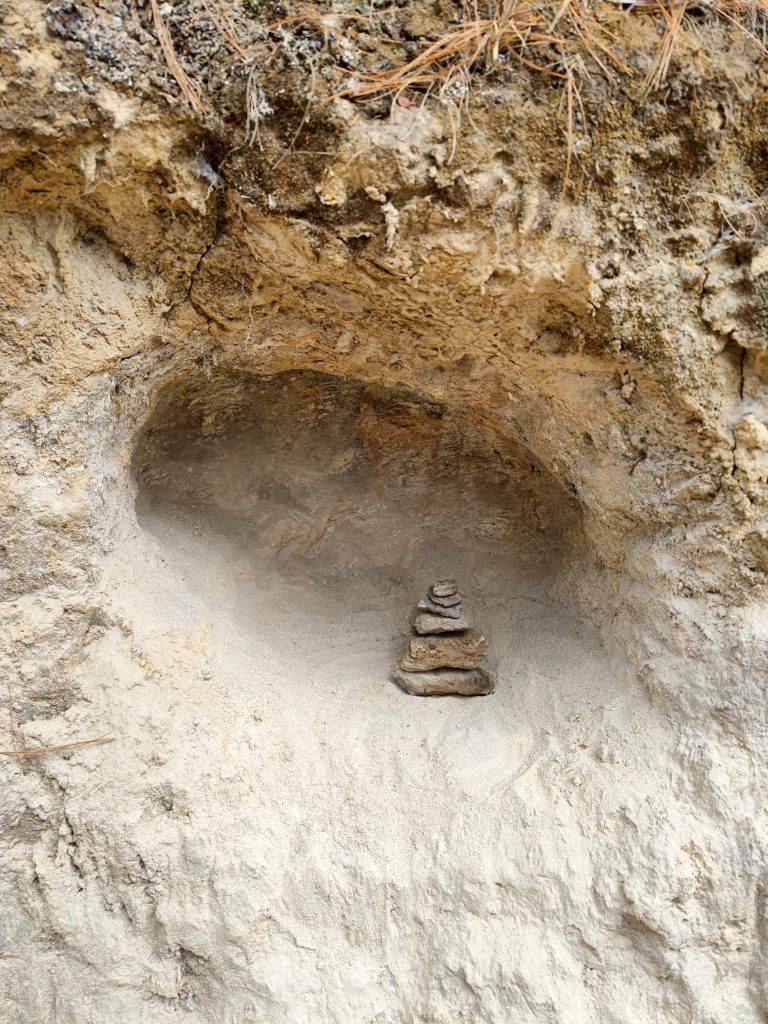
It’s quite a challenge to jot down these stories while climbing. One eye on the phone, the other on the trail, all while trying not to miss the scenery.
Returning to the tale, this spot once housed a humble cave, then a small temple, eventually blossoming into the grand monastery we see today. Within the monastery lies a concealed cave, its door reserved for special occasions and special individuals.
Every Buddhist temple in Bhutan features these iconic figures—the great Buddha, the pioneer of Buddhism; the second Buddha, who brought Buddhism to Bhutan; and the discoverer of Bhutan—a Tibetan figure who laid claim to this territory as Bhutan.
The narrative takes a dramatic turn as the second Buddha faces adversity. Accused of being a demon due to his miraculous displays, he endures being buried alive by fearful Indians. Convinced by ministers, the Indian king sanctioned the act. Yet, when Indians returned to witness the aftermath, they found not ashes, but a lake with the indestructible Buddha seated within a lotus flower.
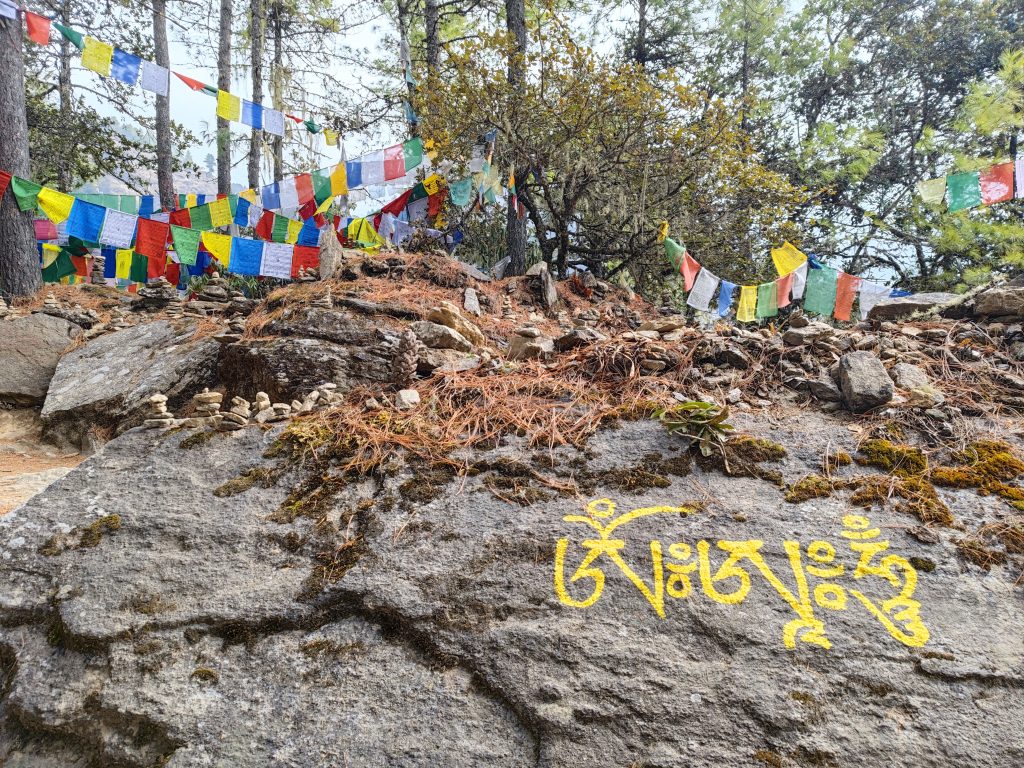
After a rewarding walk, we arrive at the monastery, where guards request visitors to leave bags, phones, and everything else behind. Although there’s no key for the lockers, the sacred atmosphere instills confidence that theft is unlikely in such holy spaces. We choose to trust in that.
Within the monastery, a collection of nine temples awaits exploration. In each sacred space, tradition calls for a moment of reverence – a genuflection, a banknote pressed to the forehead, and a whispered prayer. It’s believed that coupling a prayer with a monetary offering ensures its fulfillment. Each deity is enlisted for a specific purpose; the god of Life promises longevity, while the god of wealth ensures financial prosperity. It’s a great exercise not only to ascend the temple but also to kneel before the statues over 50 times.
One remarkable spot features a stone with the fingerprints of a revered llama. Legend has it that aligning one’s thumb with this sacred print, eyes closed, brings immense joy. The profound promise is that the fortunate individual’s parents will break free from the perpetual cycle of rebirth and attain liberation. To the surprise of all, I manage to align my finger precisely with the sacred imprint, wishing my dear parents a release from the burdens of continual reincarnation.
Exploring the captivating narratives surrounding each god’s origin and the symbolism behind their myriad eyes and faces, I’m immersed in the rich tapestry of Bhutanese spirituality. Regrettably, my phone is securely stored in the locker, and my mental memory card is brimming, so I can’t share all the enchanting stories I’ve heard. Nevertheless, I’m confident that if you’re here, Bhutan has already woven its spell, leaving you equally enchanted by its mystique.
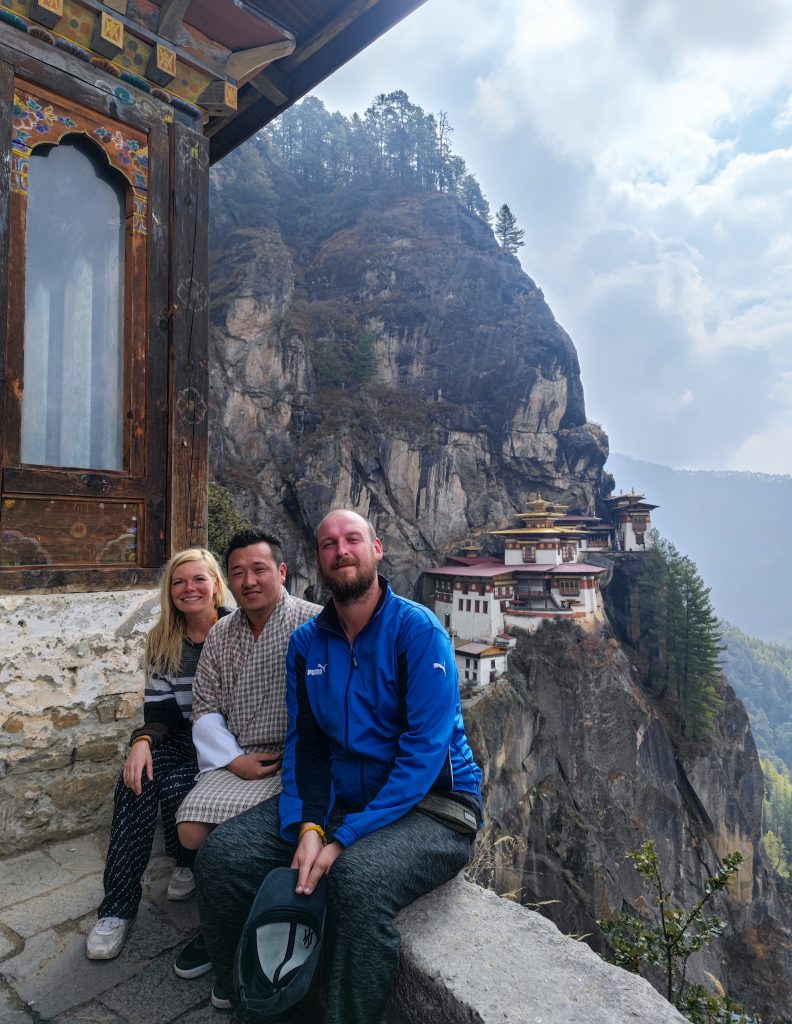
We share a lighthearted chuckle as the vigilant guards watch over us with a protective gaze, cautioning us like caring guardians: “Don’t venture too close to the edge; you might take a tumble!” Our guide mirrors their watchful eye, treating us like truly exclusive guests. A new tradition takes root as we decide to leave our mark in special places—tying bows adorned with our names and the date. A symbol of remembrance that, if someone else finds it in the future, they can connect with our journey. Although we lack a Latvian flag this time, a string of bookmarks from the planner serves as our improvised emblem. After all, a well-crafted trip hinges on a good plan, which, in turn, allows for delightful deviations. The planner, with its embedded bookmark, becomes a cherished travel tool, symbolic of the journey’s unique narrative.
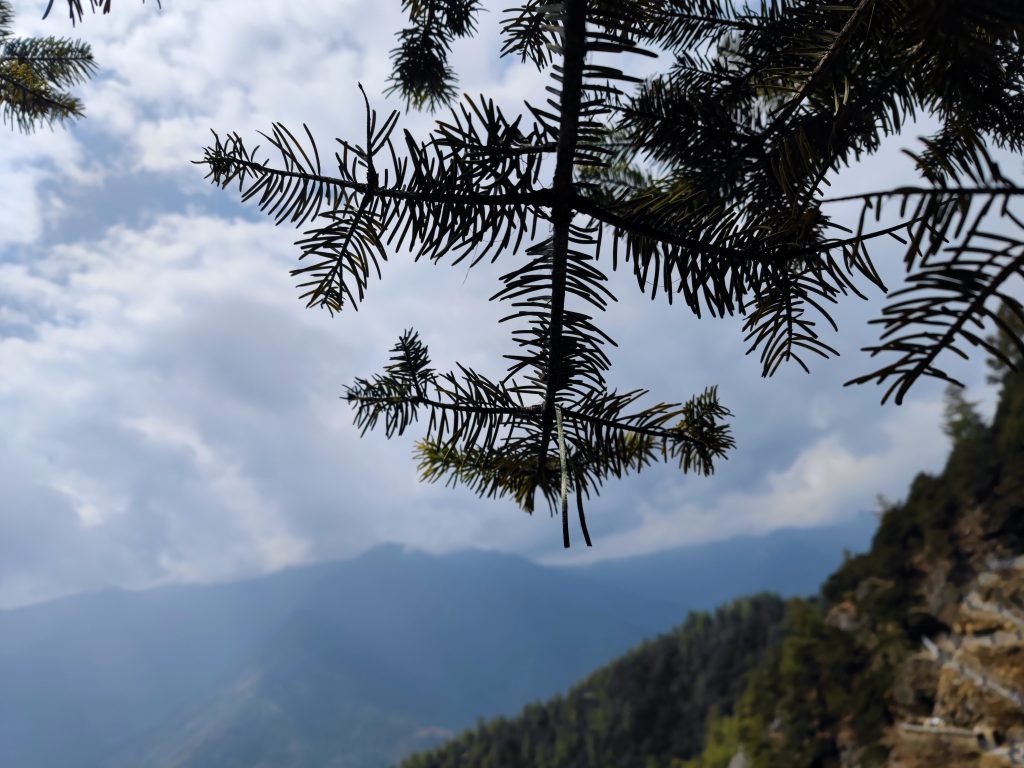
With our trusty local dog guide by our side, we begin our descent down the mountain, and as always, questions persist. Interestingly, many “must-know” facts about Bhutan found on the internet turn out to be inaccurate. For instance, the common belief that inheritance (land, house, and animals) typically passes to the eldest son is debunked; instead, it often goes to the eldest daughter. Additionally, the tradition of a man moving into his new wife’s home until he can “earn his wages” is considered an old practice that no longer holds true. Contrary to another misconception, Bhutanese are not forbidden to marry foreigners—love knows no boundaries. While polygamy exists, it is limited to the families of lamas and kings, not among the general population.
After a four-hour journey down the mountain, we are warmly greeted by our cheerful driver. It’s a swift turnaround, quite uncommon for tours that typically span the whole day. The mountains, however, hold no challenge for us compared to more strenuous hikes we’ve tackled.
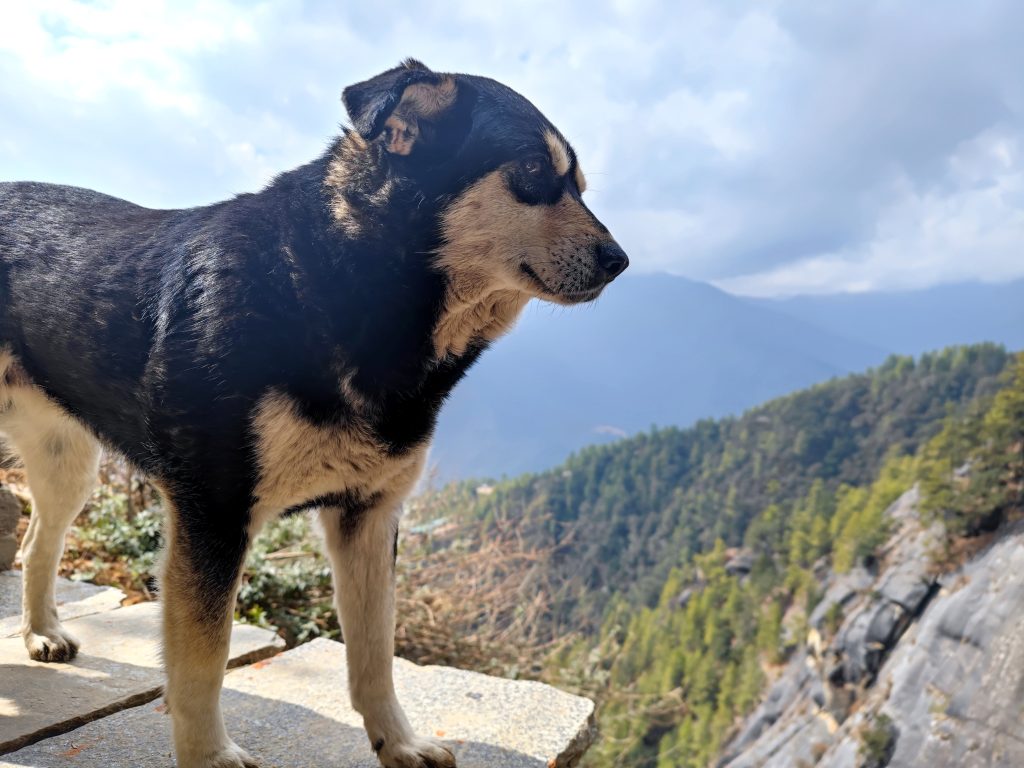
Moreover, it’s only noon, and our curiosity beckons us to Kyichu Lhakhang—an ancient monastery dating back to 659, marking the genesis of Buddhism in Bhutan. Intriguingly, today, precisely at this hour, the mother of the fourth king is performing rituals inside the temple. While such events occasionally occur, visitors are barred from entering during these sacred moments, which can extend for hours. Considering this, we opt to gracefully forgo this particular experience.
Paro also boasts a fortress and a museum, but the entrance fees for each point of interest amount to around 13 euros. Given our preference and the knowledge that we’re not avid museum-goers, we choose to skip these attractions. Having already witnessed the grandeur of formidable fortresses, we decide to focus on the unique experiences that truly resonate with us.
Lunchtime beckons, and we eagerly opt for cheese dumplings, a local favorite known for their delectable taste and, of course, a generous serving of chili. We share a light-hearted laugh about the “no-kill” ethos prevalent in Bhutan. Witnessing a mosquito in action, my husband deftly catches it in his hand but releases it without harm. He recounts a similar incident in an elevator, where he caught a fly that had been hitching a ride. To his inquiry about squashing it, the guide had responded with a firm “no.” This extends to mosquitoes as well; they are left unharmed, prompting the question, “In your country, do you simply squash mosquitoes without mercy?” There’s a peculiar post-Bhutan sensation—we leave mosquitoes be. These persistent mosquitoes, as our Bhutanese hosts explain, bite out of necessity—they bite humans because it’s hard for them to penetrate the skin of animals. Everyone has their role and place in this life on Earth. It’s a harmonious interplay of existence where each being contributes uniquely to the intricate tapestry of our shared existence.
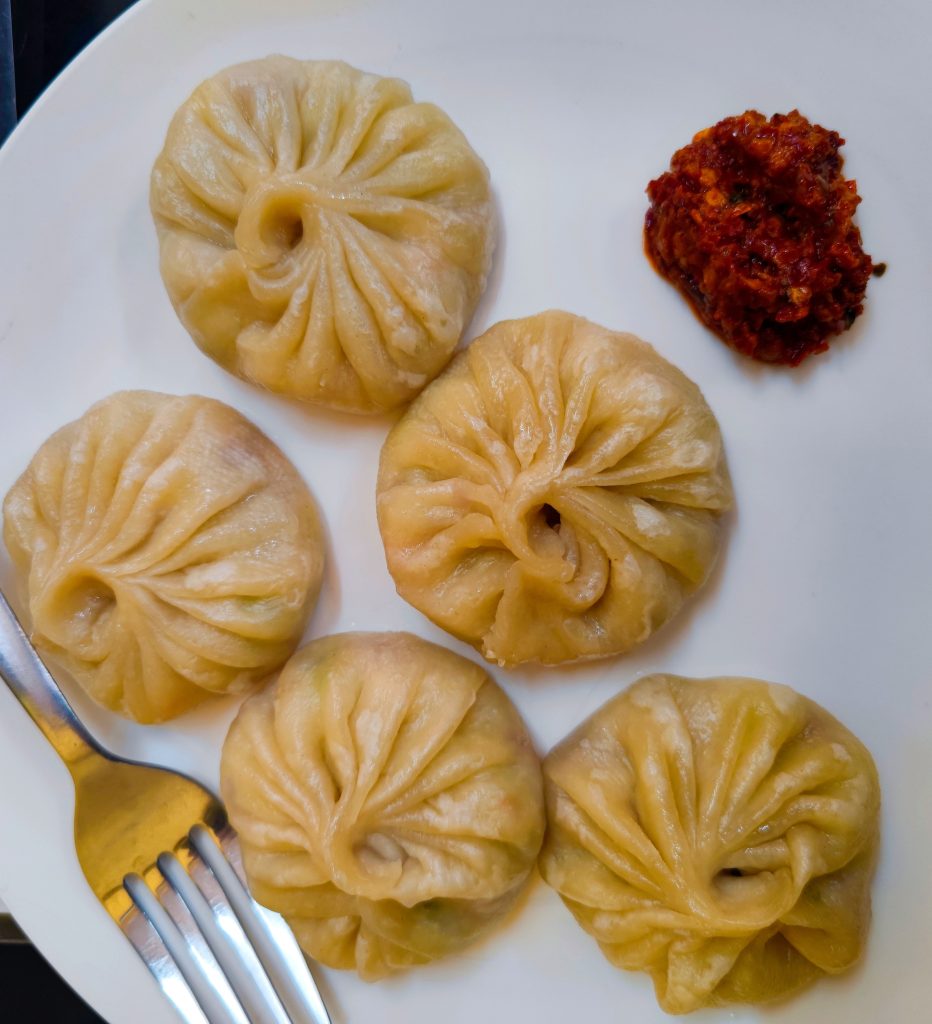
Embarking on a leisurely stroll through Paro, we find souvenir shops adorning every corner. These charming stores offer an array of items, from prayer beads crafted from the Bodi tree, where the Buddha attained enlightenment, to various accessories for Buddhist rituals and symbols of good luck. Amid these cultural treasures, we encounter a particularly intriguing item—cordyceps. This rare fungus thrives on specific larvae in Bhutan’s highland regions above 3,800 meters. Cordyceps hold a special place in traditional practices, especially among the Chinese, who value it as a stimulant, a purported sex tonic, and an “adaptogen” believed to boost energy and endurance. Renowned as the world’s most expensive mushroom, it commands staggering prices ranging from 10,000 to 50,000 USD per kilogram. For centuries, people have turned to this remarkable fungus for overall health benefits and as a long-term treatment for various health issues, from impotence to cancer. Packed with essential nutrients, including vitamins E, K, B1, B2, B12, all essential amino acids, sugars, polysaccharides, proteins, sterols, and an array of macro and microelements, cordyceps has earned its esteemed status.
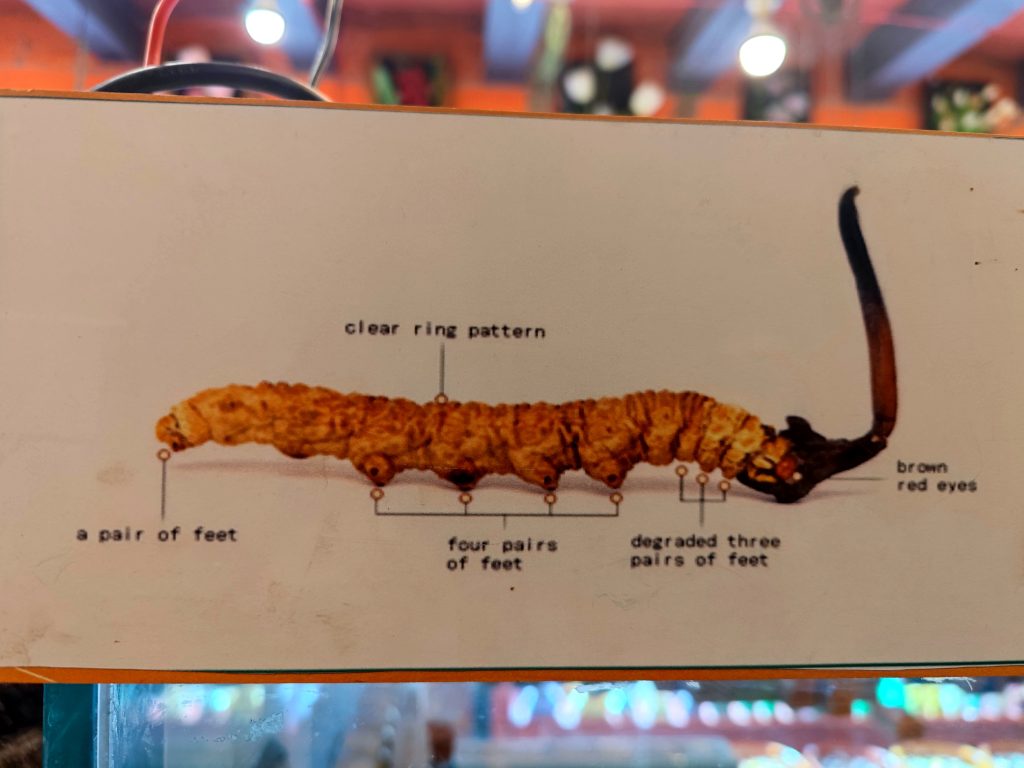
The rarity of this mushroom, which grows on a caterpillar, coupled with its demand, especially in Chinese culture, contributes to its exorbitant cost. Notably, the Chinese Olympic team’s success, winning nine gold medals after using cordyceps, underscores its perceived potency. Although the committee once categorized it as medicine, the games continued. Fascinated by its allure, we opt for a more accessible indulgence—a cordyceps tea, where the mushroom content is a modest 0.5% in the bag. This is what we can afford. By the way, acquiring a license to harvest cordyceps is restricted, with only Bhutanese residents in the northern regions, deemed wealthy due to the high demand, eligible to obtain one.
The day concludes with traditional Bhutanese brandy, mixed with butter and egg, heated slightly to ensure the egg is not entirely raw. Though it might sound like a potion for digestive distress, in Bhutan, it’s a local specialty.
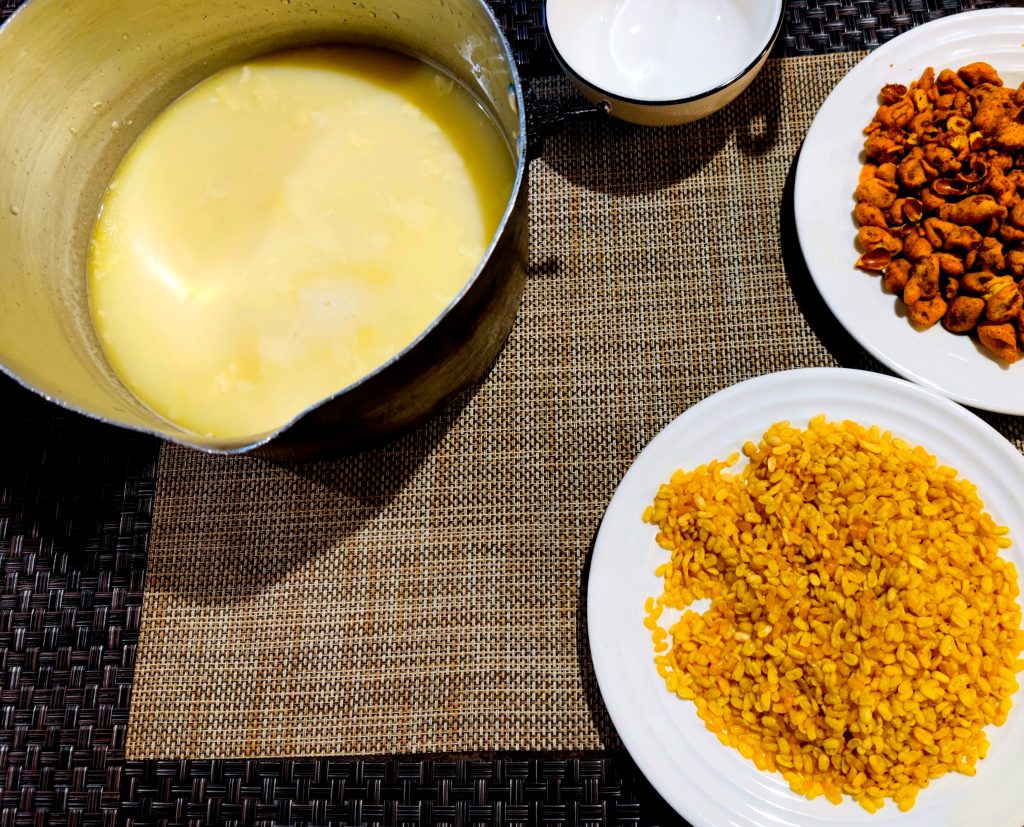
As we reflect on another captivating day in Bhutan, it dawns on us that this marks the final full day of our Bhutanese adventure. Though our departure looms for tomorrow, our hearts linger, and we’re determined to savor every remaining moment. Stay tuned for the recounting of our last day in this enchanting land!